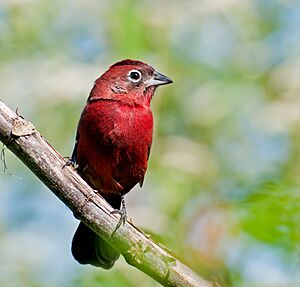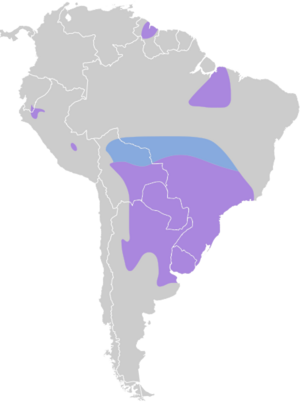Red pileated finch facts for kids
Quick facts for kids Red pileated finch |
|
|---|---|
 |
|
| Conservation status | |
| Scientific classification | |
| Genus: |
Coryphospingus
|
| Species: |
cucullatus
|
 |
|
The red pileated finch (Coryphospingus cucullatus) is a colorful bird also known as the red-crested finch. It belongs to the Thraupidae family, which includes many types of tanagers.
You can find this bird in several South American countries. These include Argentina, Bolivia, Brazil, Ecuador, French Guiana, Guyana, Paraguay, and Peru. It lives mostly on the eastern side of the Andes mountains.
Red pileated finches like to live in different kinds of places. They can be found in warm, dry forests, wet lowland forests, and dry shrubland. They can even live in areas where forests have been cut down. This bird is quite common, and experts say it is a "least concern" species. This means it is not currently in danger of disappearing.
Contents
Understanding the Red Pileated Finch's Family Tree
This bird was first described by a German scientist named Philipp Ludwig Statius Müller in 1776. Scientists use special tests to study how different birds are related. These tests show that the red pileated finch and its close relative, the grey pileated finch, are part of the Thraupidae family. This family is also known as the tanager family.
These two finches are like sisters to a group of other tanagers. This group includes birds like the fulvous-crested tanager, the black-goggled tanager, the shrike tanagers, and the grey-headed tanager.
Different Types of Red Pileated Finches
There are three main types, or subspecies, of the red pileated finch:
- C. c. cucullatus: This type lives in Guyana, Suriname, and northeastern Brazil.
- C. c. fargoi: You can find this one in Peru, Bolivia, western Paraguay, and northern Argentina.
- C. c. rubescens: This type lives in Brazil, eastern Paraguay, northeastern Argentina, and Uruguay.
What Does a Red Pileated Finch Look Like?
The red pileated finch is about 13.5 centimeters (5.3 inches) long. Both male and female birds have a white ring around their eyes.
Male Red Pileated Finches
The male bird is very striking. It has a bright red crest on its head and a black cap. Its upper body is a dark wine-red color, and its lower back (rump) is also reddish. The feathers on its belly are a dull reddish color.
Female Red Pileated Finches
Female red pileated finches look a bit different from the males. They do not have the red crest or the black cap. Their upper body feathers are more brown than the males'. The female's throat is white, and her belly feathers are pink.
Where Do Red Pileated Finches Live?
This bird lives across a large area in South America. Its main home stretches from southern Brazil and northern Argentina. This includes places like Brasília and Rio de Janeiro in the north, all the way down to Buenos Aires in the south. It also extends west towards the Andes mountains.
Besides this main area, there are smaller groups of these birds living in other places. You can find them in dry mountain valleys in Ecuador, Peru, and Bolivia. There's also a group in northern Brazil and another in Suriname, Guyana, and French Guiana.
Red pileated finches usually live below 1,500 meters (4,900 feet) in height. However, in the Cusco area of southeastern Peru, they can be found as high as 2,000 meters (6,600 feet).
Conservation Status: Are Red Pileated Finches Safe?
The red pileated finch is generally a common bird. Its numbers seem to be staying steady, which is good news. It lives in a very large area, so there's plenty of space for it. Because of this, the International Union for Conservation of Nature has decided that its conservation status is "least concern". This means that experts are not worried about this species becoming endangered anytime soon.


